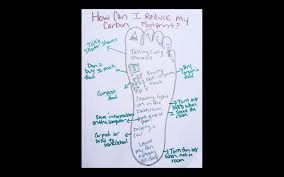 For more information on the topic of Carbon Footprints, check out the University of Michigan’s Center for Sustainable Systems' Carbon Footprint Factsheet.
For more information on the topic of Carbon Footprints, check out the University of Michigan’s Center for Sustainable Systems' Carbon Footprint Factsheet.
The curated collection below contains 10 videos, 3 podcasts and 6 games/activities. To access the resource, click on the image below the resource title.
Videos:
Ask Ruff: The Green Edition
 Grade Level: K-3
Grade Level: K-3
Duration: 2 minutes 37 seconds
Description: In this video from the PBS KIDS program Fetch! with Ruff Ruffman, Ruff answers questions about going green. Students will learn how they can do less harm to the environment when they ride in a car, choose the best tree to plant in their backyards, and how technology can be used to help the environment.
Concrete Climate Ideas Girl Scouts Talk Building Materials and Embodied Carbon Updated
 Grade Level: 3-6
Grade Level: 3-6
Duration: 9 minutes 8 seconds
Description: This video made by Girl Scout Troops 1477 and 1952 of the Wisconsin Badgerland Council talks about the carbon footprint of concrete. Students will learn about the embodied carbon of concrete and about more eco-friendly options for building materials.
The Carbon Footprint Of A Sandwich
 Grade Level: 3-8
Grade Level: 3-8
Duration: 3 minutes 5 seconds
Description: This video from NPR's Skunk Bear traces the carbon footprint of a BLT. Through this engaging video, students will learn how something as simple as a sandwich can impact the planet.
Global Energy and Carbon: Tracking Our Footprint
![]() Grade Level: 9-12
Grade Level: 9-12
Duration: 26 minutes 46 seconds
Description: This documentary from Prairie Public follows six families, two from the U.S., two from India, and two from Cameroon. Students will learn how the energy each family uses contributes to their carbon footprint and what aspects of their lives contribute the most significantly to their household carbon footprint. Note: This documentary was posted in 2011 so some of the information may be dated.
Global Warming, It's All About Carbon | Krulwich Wonders | NPR
 Grade Level: 3-8
Grade Level: 3-8
Duration: Five videos ranging in duration from 2 minutes and 39 seconds to 4 minutes and 16 seconds.
Description: This collection of videos from NPR discusses how global warming and carbon are related. Students will learn about the properties of carbon, its connection to climate change, and how individuals can change their reliance on carbon-based fuels to help fight climate change.
Episode 1, Episode 2, Episode 3, Episode 4, Episode 5
Simple Animated Video: What is a carbon footprint? What can you do about yours?

Grade Level: 6-12
Duration: 2 minutes 7 seconds
Description: This short video discusses the different areas of one's life that contribute to their carbon footprint. Additionally, students will learn ways that they can reduce their own carbon footprints.
Will Climate Change Stop If We Stop Emitting Carbon Tomorrow? | Hot Mess
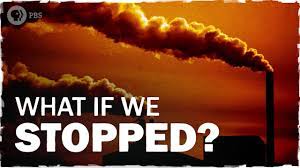 Grade Level: 6-12
Grade Level: 6-12
Time: 5 minutes 56 seconds
Description: This video from Hot Mess by PBS Digital Studios discusses what would happen if humans stopped emitting carbon dioxide. Students will learn that even if we stopped burning carbon-emitting fuels, both earth's temperature and sea levels would continue to rise because of heat retention in the oceans and the fact that carbon dioxide stays in the atmosphere for a long time. However, students will also learn about the immediate benefits that people and the planet would experience if we stopped burning carbon-based fuels.
How to reduce your environmental footprint | WWF
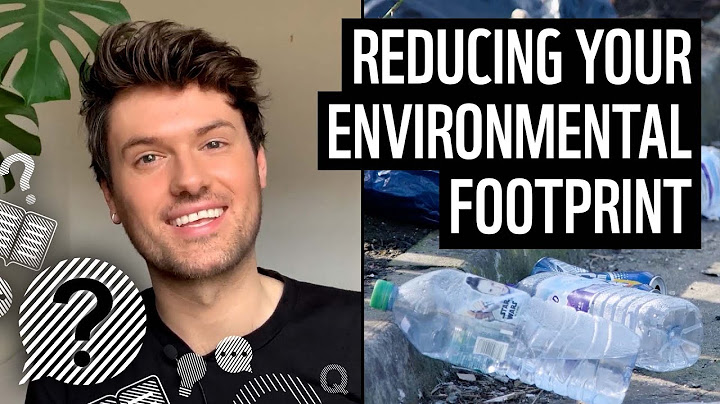 Grade Level: 6-12
Grade Level: 6-12
Duration: 5 minutes
Description: This video from the World Wildlife Fund UK (WWF UK) discusses how individuals can reduce their carbon footprint. Students will learn that they can reduce their carbon footprint by changing the foods they eat, the way that they purchase goods, the way that they travel, and where their energy is sourced.
Power Pioneers - Reducing Our Carbon Footprint
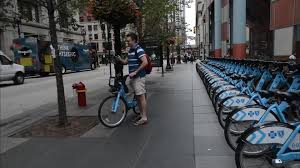 Grade Level: 9-12 (may be suitable for younger audiences with a long attention span)
Grade Level: 9-12 (may be suitable for younger audiences with a long attention span)
Duration: 26 minutes 47 seconds
Description: This video is from PBS’s EcoSense for Living. Students will learn different ways that individuals and cities are working to curb their carbon footprints and mitigate the effects of climate change.
What's the Deal with Carbon?
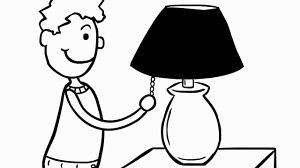 Grade Level: 5-8
Grade Level: 5-8
Duration: 3 minutes 3 seconds
Description: This video from the Bell Museum of Natural History at the University of Minnesota explains how human activities disrupt the natural carbon cycle. Students will learn what the carbon cycle is and how actions such as burning fossil fuels and chopping down trees can cause the carbon cycle to become unbalanced.
Podcasts:
5 Ways To Cut Carbon Emissions At Home
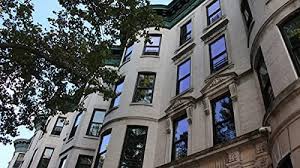 Grade Level: 9-12 (may be suitable for younger audiences with a long attention span)
Grade Level: 9-12 (may be suitable for younger audiences with a long attention span)
Duration: 17 minutes
Description: Listening to this episode of Short Wave from NPR, students will learn five ways that individuals can reduce their household’s carbon emissions.
Meet The Climate Scientist Trying to Fly Less for Work
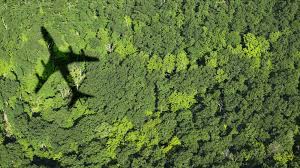 Grade Level: 9-12 (may be suitable for younger audiences with a long attention span)
Grade Level: 9-12 (may be suitable for younger audiences with a long attention span)
Duration: 11 minutes 56 seconds
Description: In this podcast from NPR’s Short Wave, climate scientist Kim Cobb talks about what factors influenced her to stop flying. Cobb’s actions may inspire students to look for ways they can cut carbon emissions in their own lives.
Episode 212: Talking Carbon Footprinting
 Grade Level: 9-12
Grade Level: 9-12
Duration: 43 minutes 36 seconds
Description: This episode of Talk Policy to Me from Berkeley University discusses how individuals can calculate their carbon footprint. Additionally, students will learn how the hosts of the podcast took steps to reduce their carbon footprints.
Games/Activities:
Go Green! Challenge Worksheet
 Grade Level: 3-5
Grade Level: 3-5
Duration: Varies
Description: Educators can use this worksheet in combination with the video from Fetch listed above. Students will take the “Go Green! Challenge” and monitor how far they drive, how much electricity their family uses, how many pieces of paper they use, how many grocery bags they use, how much water they use, and how much trash they produce in their lunch for three weeks, ultimately discovering how their daily activities impact the planet.
Carbon Footprint activity
Grade Level: 3-6
Duration: 15-20 minutes
Description: In this activity from the National Park Service, students will trace their foot. Inside their traced foot, they will list activities they do that contribute to their carbon footprint. Students will consider concrete ways they can change their habits to reduce their carbon footprint.
Kids Calculator - Park City
 Grade Level: 3-8
Grade Level: 3-8
Duration: 10 minutes
Description: This calculator from Park City asks simple questions about a student's everyday activities. Students will calculate the environmental impact of their lifestyle.
Ecological Footprint Calculator
 Grade Level: 6-12
Grade Level: 6-12
Duration: 15-20 minutes
Description: This calculator is from the Global Footprint Network. Students will answer questions about their lifestyle and find out their personal “Earth Overshoot Day,” the number of earths needed to support their lifestyle, their carbon footprint, and their ecological footprint. Note: Younger students may need a parent's help to figure out some of the information requested by this calculator.
CO2: How Much Do You Spew?
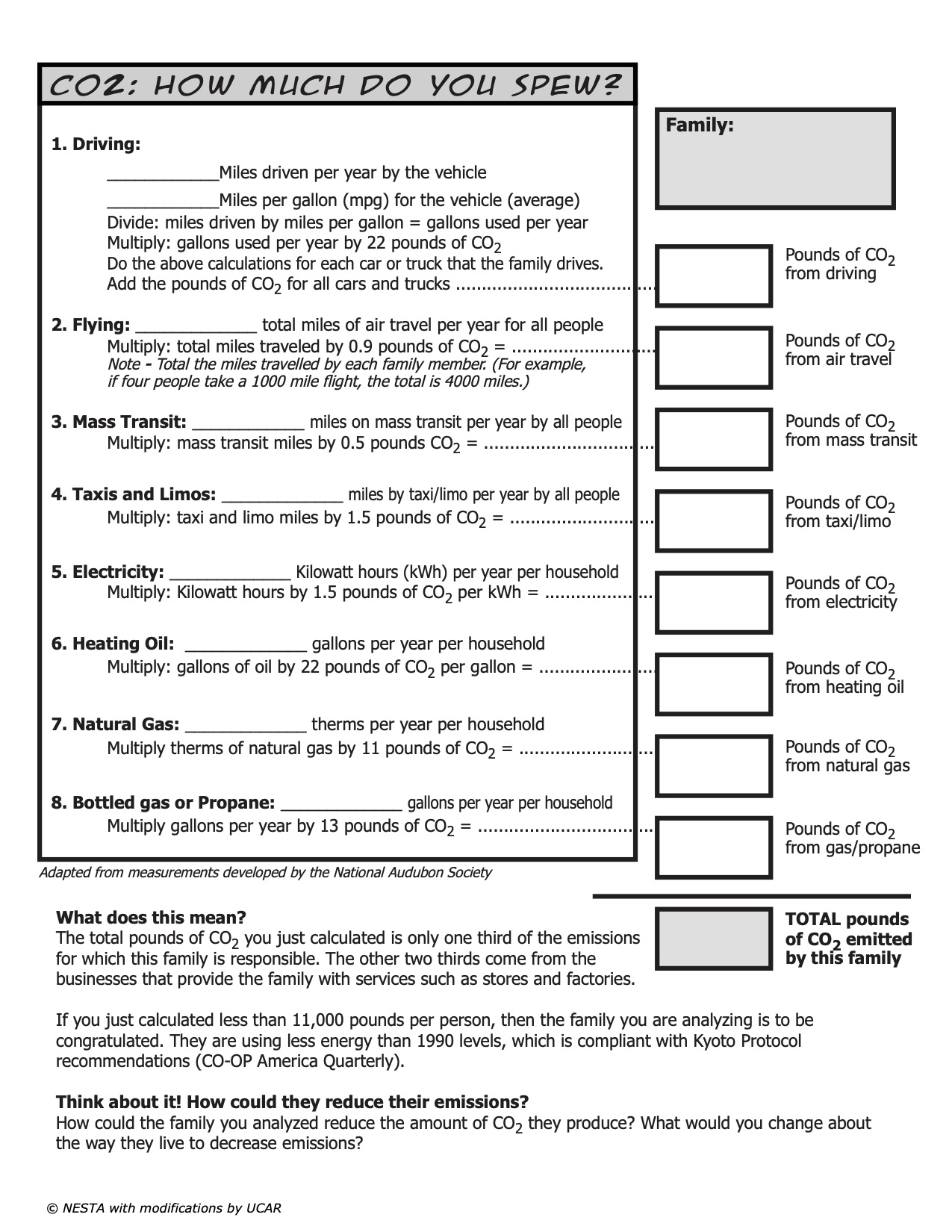 Grade Level: 6-12
Grade Level: 6-12
Duration: 45-55 minutes
Description: In this activity from the University Corporation for Atmospheric Research (UCAR), students will explore in groups how the activities of different families impact their household carbon emissions.
PDF Link
CoolClimate Calculator
Grade Level: 6-12
Duration: 20 minutes
Description: Similar to the Ecological Footprint Calculator, but from the University of Berkely. Students will answer questions about their lifestyle and find out their household’s carbon footprint. Note: Younger students may need a parent's help to figure out some of the information requested by this calculator.
